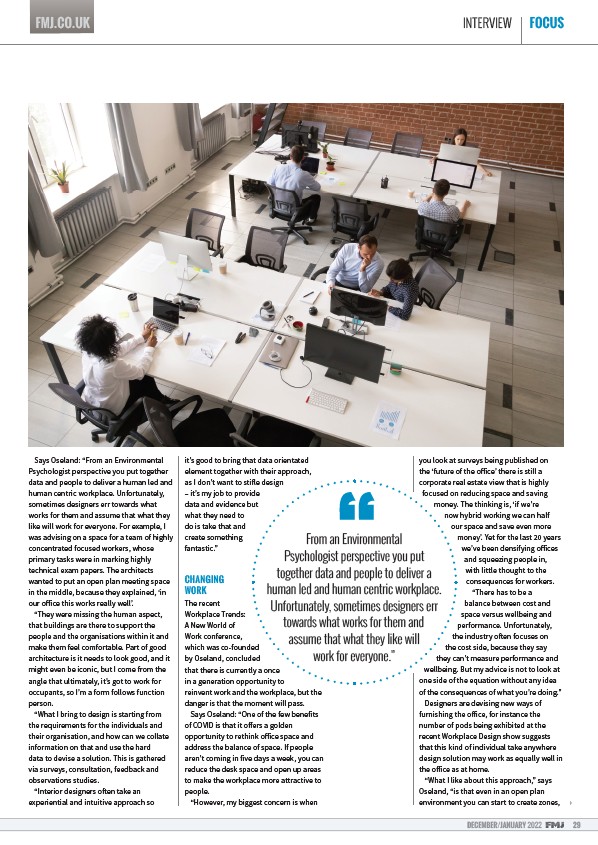
FMJ.CO.UK INTERVIEW FOCUS
DECEMBER/JANUARY 2022 29
Says Oseland: “From an Environmental
Psychologist perspective you put together
data and people to deliver a human led and
human centric workplace. Unfortunately,
sometimes designers err towards what
works for them and assume that what they
like will work for everyone. For example, I
was advising on a space for a team of highly
concentrated focused workers, whose
primary tasks were in marking highly
technical exam papers. The architects
wanted to put an open plan meeting space
in the middle, because they explained, ‘in
our oŽ ice this works really well’.
“They were missing the human aspect,
that buildings are there to support the
people and the organisations within it and
make them feel comfortable. Part of good
architecture is it needs to look good, and it
might even be iconic, but I come from the
angle that ultimately, it’s got to work for
occupants, so I’m a form follows function
person.
“What I bring to design is starting from
the requirements for the individuals and
their organisation, and how can we collate
information on that and use the hard
data to devise a solution. This is gathered
via surveys, consultation, feedback and
observations studies.
“Interior designers o— en take an
experiential and intuitive approach so
it’s good to bring that data orientated
element together with their approach,
as I don’t want to stifle design
– it’s my job to provide
data and evidence but
what they need to
do is take that and
create something
fantastic.”
CHANGING
WORK
The recent
Workplace Trends:
A New World of
Work conference,
which was co-founded
by Oseland, concluded
that there is currently a once
in a generation opportunity to
reinvent work and the workplace, but the
danger is that the moment will pass.
Says Oseland: “One of the few benefits
of COVID is that it oŽ ers a golden
opportunity to rethink oŽ ice space and
address the balance of space. If people
aren’t coming in five days a week, you can
reduce the desk space and open up areas
to make the workplace more attractive to
people.
“However, my biggest concern is when
you look at surveys being published on
the ‘future of the oŽ ice’ there is still a
corporate real estate view that is highly
focused on reducing space and saving
money. The thinking is, ‘if we’re
now hybrid working we can half
our space and save even more
money’. Yet for the last 20 years
we’ve been densifying oŽ ices
and squeezing people in,
with little thought to the
consequences for workers.
“There has to be a
balance between cost and
space versus wellbeing and
performance. Unfortunately,
the industry o— en focuses on
the cost side, because they say
they can’t measure performance and
wellbeing. But my advice is not to look at
one side of the equation without any idea
of the consequences of what you’re doing.”
Designers are devising new ways of
furnishing the oŽ ice, for instance the
number of pods being exhibited at the
recent Workplace Design show suggests
that this kind of individual take anywhere
design solution may work as equally well in
the oŽ ice as at home.
“What I like about this approach,” says
Oseland, “is that even in an open plan
environment you can start to create zones,
From an Environmental
Psychologist perspective you put
together data and people to deliver a
human led and human centric workplace.
Unfortunately, sometimes designers err
towards what works for them and
assume that what they like will
work for everyone.”